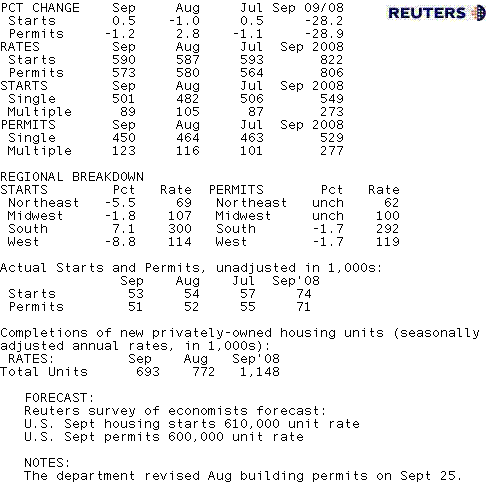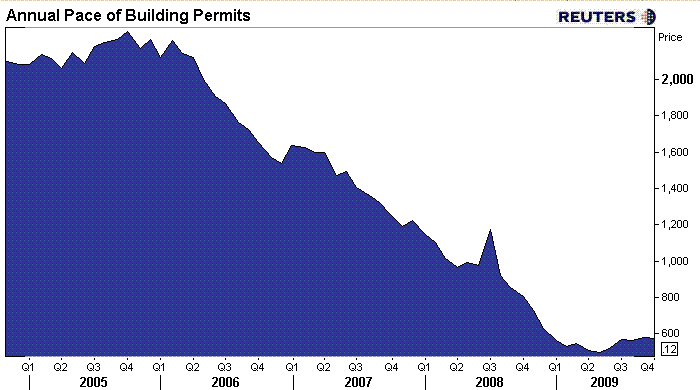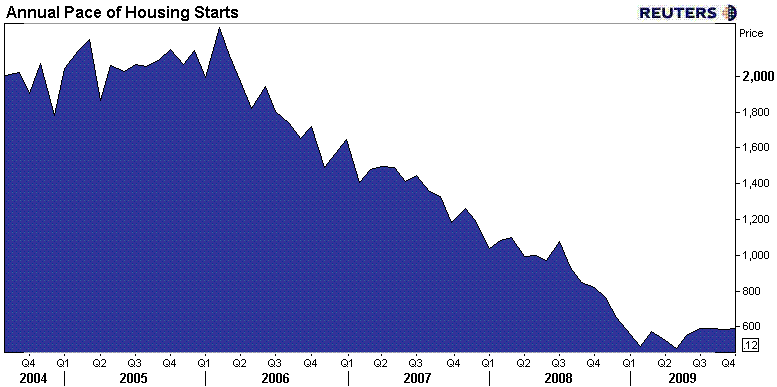The Census Department released September New Residential Construction: Building Permits, Housing Starts, and Housing Completions data this morning.
Housing Starts data estimates how much new residential real estate construction occurred in the previous month. New construction means digging has begun. Adding rooms or renovating old ones does not count, the builder must be constructing a new home (can be on old foundation if re-building). Although the report offers up single family housing, 2-4 unit housing, and 5 unit and above housing data, single family housing is by far the most important as it accounts for 70-80% of total home building.
Building Permits data provides an estimate on the number of homes planning on being built. Tracks how much future construction activity we can expect to take place. This data is a part of Conference Board's Index of Leading Economic Indicators.
Read More on How the Data is Collected
August Report: In August the total number of housing starts came in at 598,000, just 2,000 units below the consensus forecast. But, rather than being driven by single-family starts, a boost in multi-family units helped housing starts come in better than expected. Building permits for single-family homes slid 3.0% in August, pushing the annualized rate to 479,000 from the revised July read of 494,000 new starts per year. Starts for multi-family units pushed up 35.3% in the month, putting the annualized pace up 30k to 115,000.
September Report: New housing starts rose less than expected to 590,000 annualized units from a revised lower 587,000 pace in August, economists were expecting a rise of 610,000 units. The rise in new housing starts was a factor of a 3.9% increase in single family construction starts while multifamily starts fell by 15.2%. Meanwhile building permits, an indicator of future construction activity, fell by 1.2% to 573,000 annual units led by a 3.0% decline in single-family permits. Multi-family permits rose by 6.0% to 123,000 annualized units.

Last month a surge in mutlifamily home building helped boost new construction data, this month the opposite occurred. Multi-family home starts dragged down the overall outlook. These numbers dissapointed economists who assumed record high housing affordability, near record low mortgage rates, and first time home buyer stimulus would contribute to continued forward progress in the housing sector.
As building permits are a forward indicator of future housing starts, the decline in single family building permits implies housing starts will continue to slow in the months to come.
Furthermore, the general slowdown in new construction is expected to continue as builders grow increasingly nervous about the November 30 expiration of the $8,000 First Time Home Buyer Tax credit. If the tax credit is not extended, a large portion of buyer demand is expected to disappear, thus builder's will likely put new construction plans on hold until a clearer home buyer demand outlook can be created.
There are bigger issues at work here as well. The continually contracting labor market combined with still tightening mortgage credit guidelines has made the loan qualification process more difficult for prospective first time home buyers. Until job creation picks up, we expect the housing market to remain stagnate near the apparent trough which began to form in early 2009.
See below charts for illustration of stabilization. Note the sideways trend after the three year decline in new construction.
Below is the September data from the Census Department...
BUILDING PERMITS
Privately-owned housing units authorized by building permits in September were at a seasonally adjusted annual rate of 573,000. This is 1.2 percent (±1.8%)* below the revised August rate of 580,000 and is 28.9 percent (±2.2%) below the September 2008 estimate of 806,000.
Single-family authorizations in September were at a rate of 450,000; this is 3.0 percent (±1.0%) below the revised August figure of 464,000. Authorizations of units in buildings with five units or more were at a rate of 104,000 in September.
Chart: Annual Pace of Single and Multifamily Building Permits

HOUSING STARTS
Privately-owned housing starts in September were at a seasonally adjusted annual rate of 590,000. This is 0.5 percent (±9.9%)* above the revised August estimate of 587,000, but is 28.2 percent (±6.7%) below the September 2008 rate of 822,000.
Single-family housing starts in September were at a rate of 501,000; this is 3.9 percent (±9.3%)* above the revised August figure of 482,000. The September rate for units in buildings with five units or more was 78,000.
CHART: Annual Pace of Housing Starts

HOUSING COMPLETIONS
Privately-owned housing completions in September were at a seasonally adjusted annual rate of 693,000. This is 10.2 percent (±10.4%)* below the revised August estimate of 772,000 and is 39.6 percent (±5.7%) below the September 2008 rate of 1,148,000.
Single-family housing completions in September were at a rate of 464,000; this is 8.3 percent (±14.3%)* below the revised August figure of 506,000. The September rate for units in buildings with five units or more was 210,000.







